Bucatini alla Matriciana [Pictures]
Bucatini alla Matriciana [Pictures]
-
-
-
-
-
Bucatini alla Matriciana [Pictures]
-
Post #1 - January 18th, 2005, 8:38 amAntonious,
Made your recipe for Bucatini alla Matriciana tonight, brought back memories of Italy. Simple, clear, complimentary flavors. Really quite easy to make, once the ingredients were assembled.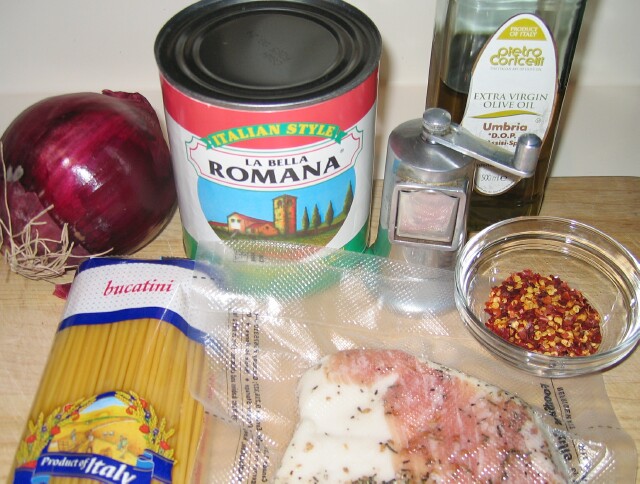
Thanks MAG for the gift of Niman Ranch guanciale, I put it to good use.
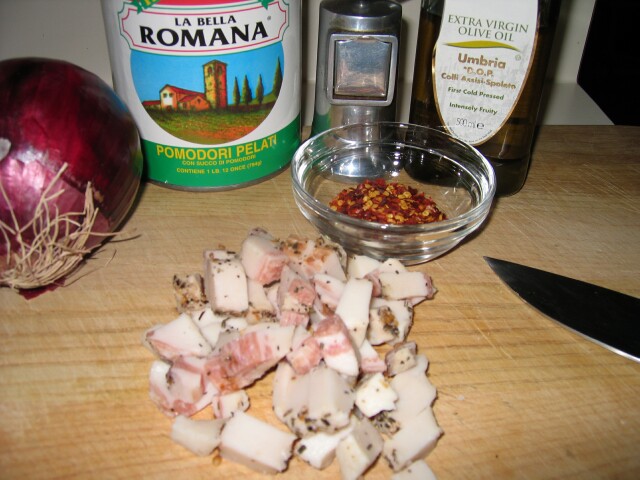
Saute cubed guanciale, remove, saute red onion until just translucent, add pomodori pelati (san marzano was only available with basil so I used La Bella Romana).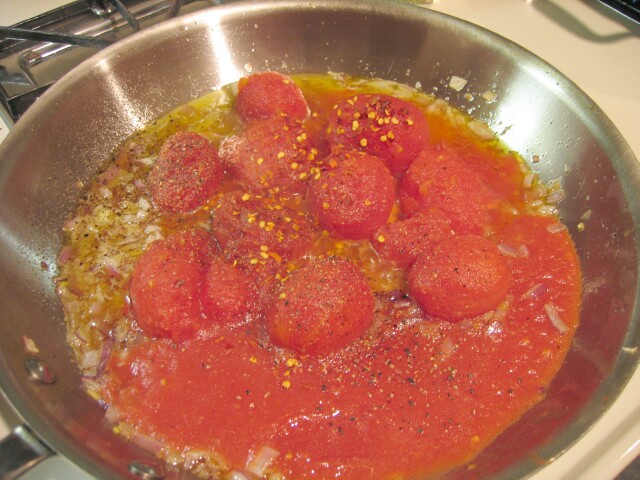
Break up tomato, black pepper, red pepper, simmer/reduce.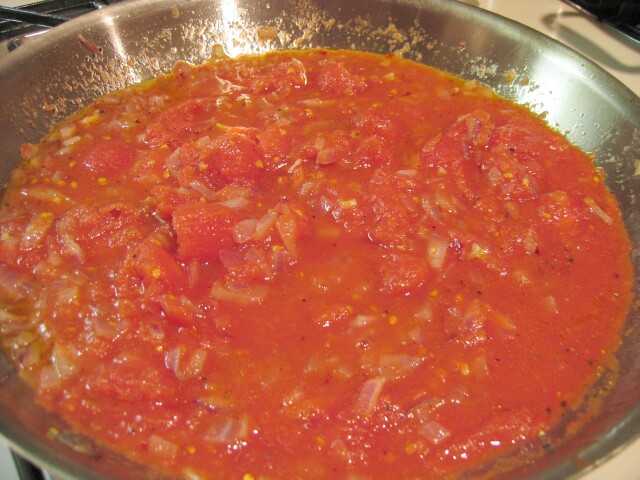
Grate pecorino romano.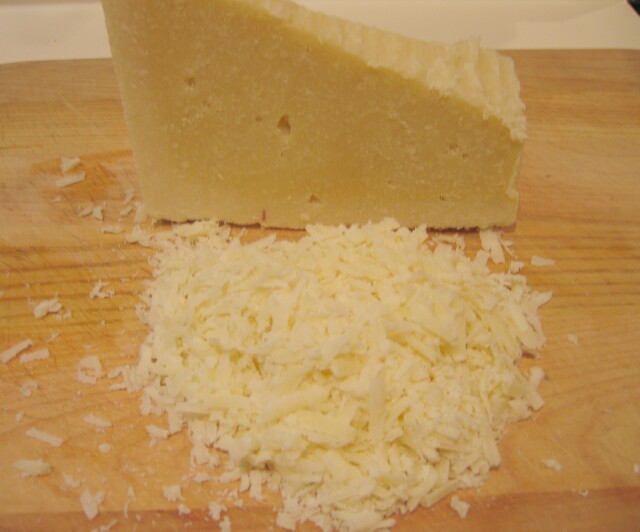
Combine, along with reserved guanciale, and place in a serving dish.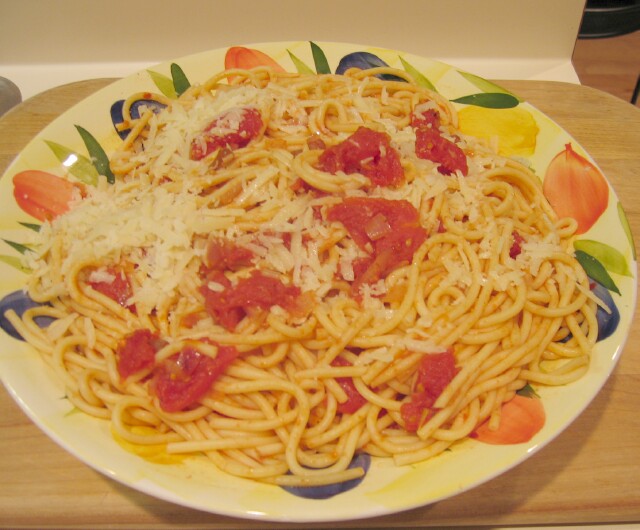
Eat and enjoy, which Ellen and I most certainly did.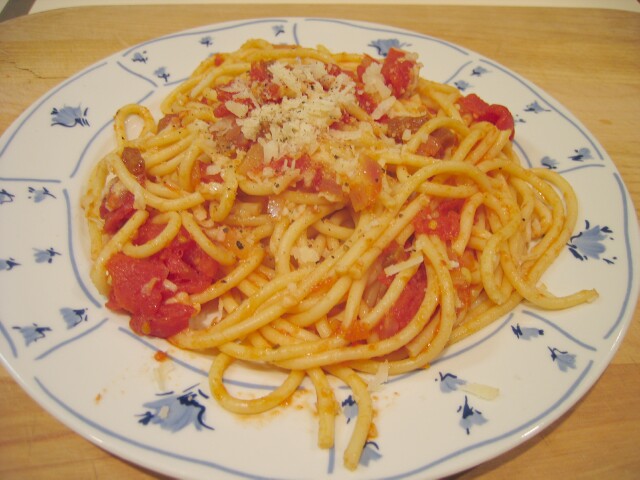
While at Caputo's I bought Cime Cicoria, I remembered you commenting on this, but don't remember your (Antonious) method of preparation. Would you be so kind as to refresh my memory.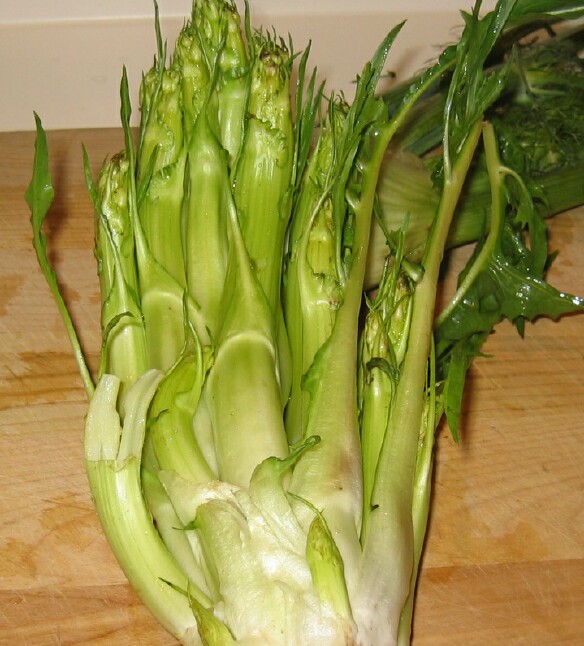
Speaking of Antonious's recipes, this summer one of my favorite snacks was his simple, yet delicious, Pa amb tom quet aka 'bread with tomato'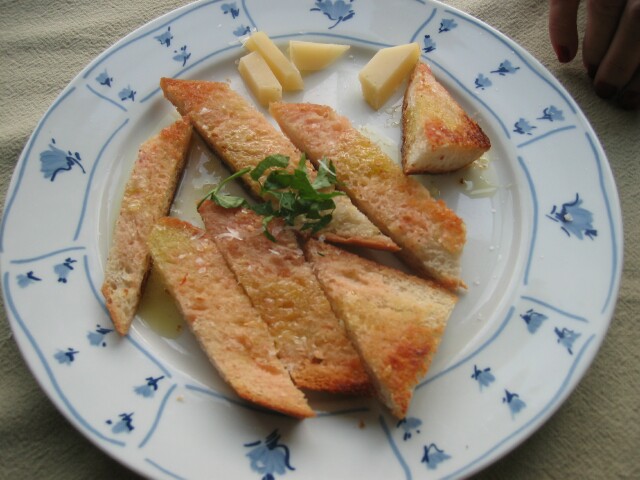
Thank you for the posting two wonderful recipes.
Next I try Choey's with garlic.
By the way, in conversation with at Carmelo Pugliese yesterday at Riviera, I learned that they will have guanciale in about a month, which means March is Bucatini alla Matriciana month. Riviera now has all three types of house-made sausage in stock, cacciatore, soprassata and capicola. The capicola was not available last time I was there and, man-o-man is the hot capicola good.
Riviera now has all three types of house-made sausage in stock, cacciatore, soprassata and capicola. The capicola was not available last time I was there and, man-o-man is the hot capicola good.
Speaking of Riviera, I previously posted about their arancini and calzone, though I mistakenly referred to the fresh mozzarella and tomato as calzone when it's actually a panzortti. According to Mike, Carmelo's son, calzone's contain meat.
Enjoy,
Gary
Caputo's Food Market
2558 N Harlem Ave
Elmwood Park, IL 60707
708-453-0155
Riviera Italian Imported Foods
3220 N Harlem Ave
Chicago, IL 60634
773-637-4252Last edited by G Wiv on January 22nd, 2005, 3:31 pm, edited 2 times in total.
-
-
Post #2 - January 18th, 2005, 10:25 amGary:
You've made my day!


I'm really glad the bucatini alla matriciana turned out so well. Even at this early hour, after having consumed a bowl of chicken soup and having no physical hunger in the belly, the pictures of the pasta and sauce, with that special yellow/orange tomato-pork-fat hue is making me hungry in the head.
***
I eat a lot of greens such as broccoli di rape, dandelions, escarole, curly endive and collards. Last spring, when Amata and I were at Caputo's in preparation for Easter we came across the cime di cicoria and they have been a nice addition to the repertoire of greens dishes we make. Unfortunately, the only place I ever see them is Caputo's and we don't get out that way as often as I would like.
The cime di cicoria that I've gotten this year have all been fairly tender and didn't need to be cooked as long as most of the other greens I make; in this regard, they're more on the side of escarole, I'd say. The flavour is also relatively much milder than broccoli di rape usually is and consequently, I think it might be best to be more restrained in dressing them, at least the first time you make them, just so you have a good sense of what they themselves taste like. The following is my basic 'greens Italian-style' recipe:
• Cut the cime di cicoria to the desired length (long stalks in half or in thirds) and wash well in a colander. I've never found these greens to be especially dirty but the stalks are hollow and to be safe I take care to rinse the stalks on the inside, in case any sand is residing there. Leave the washed greens wet in the colander. To be doubly sure to eliminate grit, one should use the bath method of washing, if the greens seem at all dirty.
• In a broad sauce-pan that has a cover or in a Dutch oven, heat some extra virgin olive oil at a medium setting.
• Depending on how many greens there are and how garlicky you want them to be, throw in one or two cloves of garlic, sliced quite thin.
• Option 1: At the same time you add the garlic to the oil, add one or two preserved anchovies (if tinned in oil, just add them straight in; if salted, soak them to decrease the saltiness and pat them dry before adding to the oil).
• When the garlic is just starting to turn gold, turn off the heat and let the garlic continue to cook till gold as the oil cools off a little.
• Option 2: When the garlic is just starting to turn gold, throw in a dose of hot red chile flakes.
• When the garlic has turned completely gold,* turn the heat back on to medium, and dump the still wet greens en masse into the pan with the oil and garlic. Any spattering should be caught in amongst the greens themselves.
• Mix the greens and oil and garlic together, adding also some salt (be careful if you're using anchovies!) and black pepper.
• Turn the heat down to low and cover.
• *Option 3: For a different, more intense flavour of garlic, let the garlic cook slightly past the golden stage to the brown stage, taking care not to let it turn really dark brown or black!. Then proceed as indicated above.
As I said, the cime di cicoria don't take all that long to cook, so keep an eye on them and check the thicker stems with a fork after a short while. I'm not really sure how minutes the whole process takes after adding the greens but it's easy enough to check and rescue them at a texture you like.
This very typical southern Italian way of treating greens results in a dish that is remarkably similar to simple Chinese preparations of greens. In fact, the first time I had Chinese broccoli at Ed's Potsticker House, I asked Amata to pass the bread and asked the waitress to bring an order of salsicce.
Antonius
Site-move related typographical problems corrected.Last edited by Antonius on November 20th, 2005, 10:50 am, edited 2 times in total.Alle Nerven exzitiert von dem gewürzten Wein -- Anwandlung von Todesahndungen -- Doppeltgänger --
- aus dem Tagebuch E.T.A. Hoffmanns, 6. Januar 1804.
________
Na sir is na seachain an cath.
-
-
Post #3 - January 18th, 2005, 12:51 pmI just have to say that this particular little thread, with gary's wonderful pics harnessing the newest technologies for sharing the oldest and most primal pleasures (OK, 2nd most primal - but pics of the lformer can be had on other boards) - the exchange of information, enthusiasm, general personal amity - all seem to embody, unflamboyantly, all the virtues and value of this entire enterprise. Sharing, learning, socializing - easily, instantly - it's everything "they" kept telling us this digital age was supposed to give us, but - in my experience heretofore - didn't. Give's me some hope for the new year. And makes me just desperate for some Caputo's guanciale and sausages."Strange how potent cheap music is."
-
-
Post #4 - January 18th, 2005, 2:25 pmBy the way, in conversation with at Carmelo Pugliese yesterday at Riviera, I learned that they will have guanciale in about a month, which means March is Bucatini alla Matriciana month. [Smile] Riviera now has all three types of house-made sausage in stock, cacciatore, soprassata and capicola. The capicola was not available last time I was there and, man-o-man is the hot capicola good.
Yes, the house-made hot capicola is unbelievable! After sampling some at the deli counter on my last visit there a couple weeks ago, I was salivating all the way back to Rogers Park and actually almost tore open the package I bought to hulp it all down in one sitting. But I didn't because I had also procured some house-made soppresata--also fantastic!--mortadella, fresh mozzarella, a variety of breads, and Riviera's wonderful house-made giardinera for sandwiches later on. Since I bought three jars of the giardinera, though, I am still making my way through it, and am constantly trying to find new uses for it, as I find it wholly addictive. Riviera is just an amazing, amazing place.....
Has anyone tried the cacciatore sausage GWiv mentions above? I am not familiar with this variety, and am wondering what it tastes like. Also, what are good sources of guanciale in the area, aside from Fox and Obel? Those pictures of the Bucatini alla Matriciana have me salivating again.....
-
-
Post #5 - January 18th, 2005, 2:33 pmK and I were at Riviera on Sunday, and not only was the hot capicolla great, but the prosciutto that we bought was head and shoulders better that what we've gotten lately and Caputo's Cheese Store, moist, tender, lush, damn. And all for $11/lb.
-
-
Post #6 - January 18th, 2005, 5:19 pmGary-san,
That looks so darn good. I can't wait for my shipment of guanciale to arrive so I can try making Bucatini alla Matriciana. It looks like something I could eat every day.
Bill/SFNM
-
-
Post #7 - January 19th, 2005, 11:22 pmAntonius wrote:- Option 2: When the garlic is just starting to turn gold, throw in a dose of hot red chile flakes
Antonius,
Went with option 2 for the cime di cicoria, no anchovies, delicious, thanks once again. Also made a simple pasta with diced capicola, garlic, red onion, red pepper flakes, fresh tomato and thinly sliced button mushroom. Don't know what you call it in Italian but, when combined with bucatini, I call it delicious.
Enjoy,
Gary
-
-
Post #8 - January 19th, 2005, 11:32 pmBill,
Don't know about every day, maybe once a week. Frankly, I'm not sure if I ever had bucatini, which I really like. Just the right density for my taste.
Frankly, I'm not sure if I ever had bucatini, which I really like. Just the right density for my taste.
I've been meaning to ask how you like your All-Clad, but will post the question in the original thread for continuities sake.
If you have the inclination a tutorial w/pictures when you start curing guanciale would be most interesting.
Enjoy,
Gary
-
-
Post #9 - January 20th, 2005, 12:05 amKenny from Rogers Park wrote:Has anyone tried the cacciatore sausage GWiv mentions above?
Kenny,
Riviera's Cacciatore has a just-noticeable red pepper heat and a distinct note of black pepper. Very flavorful and much to my taste.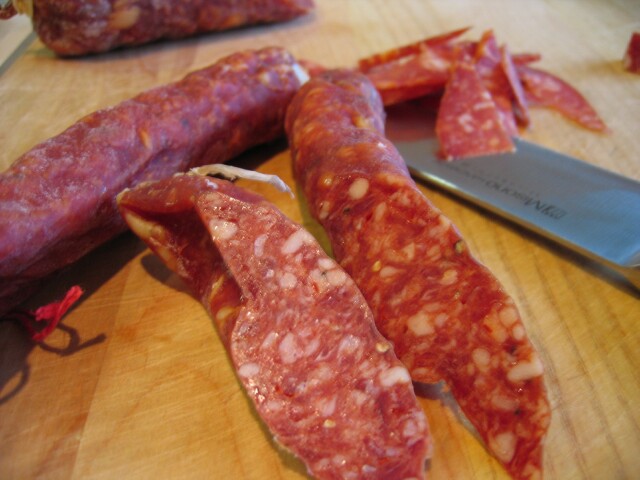
Riviera's Soprassata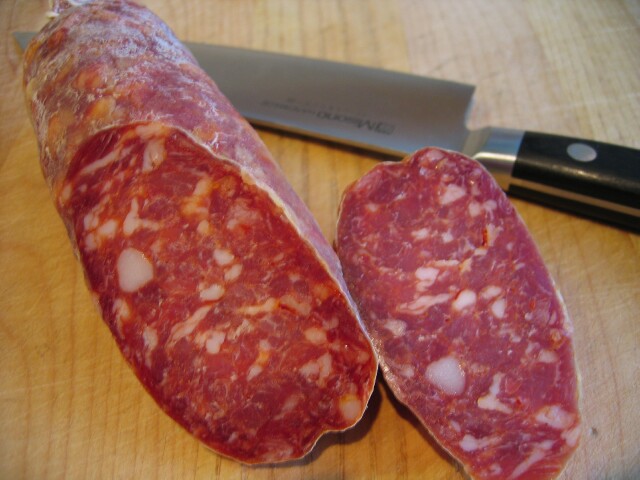
Riviera's Capicola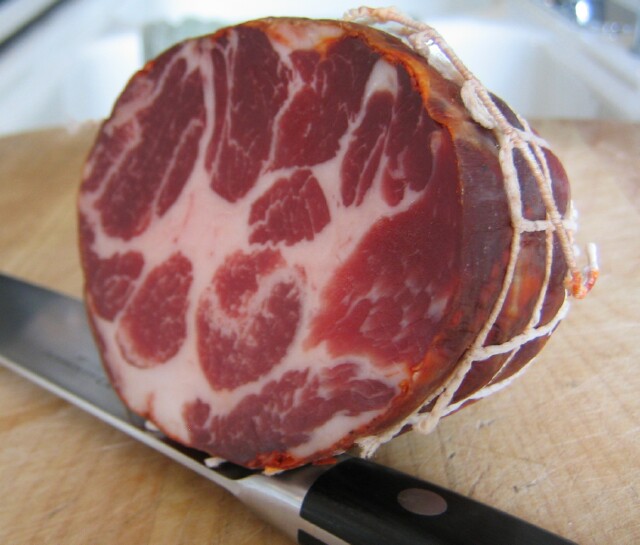
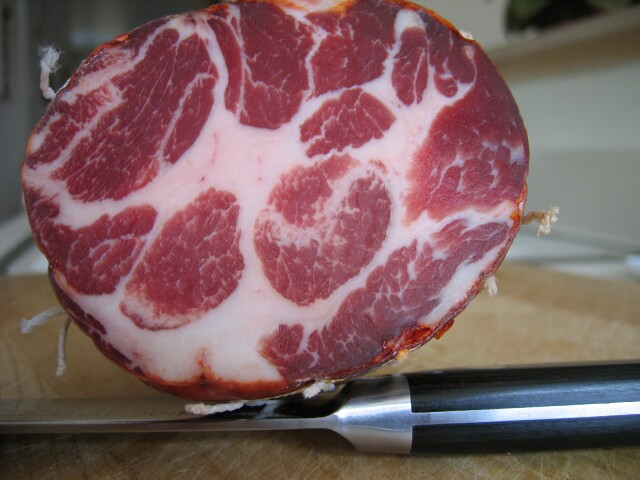
Enjoy,
Gary
-
-
Post #10 - January 21st, 2005, 4:01 pmG Wiv,
Thanks for the description--and the pictures. They are so beautiful I feel tears welling up in my eyes. Looks like you came away from Riviera with quite a haul of good stuff. I am very jealous, and will probably have to make a run out to Harlem and Belmont tomorrow.....
-
-
Post #11 - January 22nd, 2005, 2:37 amGary-san:
Antonius' recipe calls for a small can of tomatoes. I notice you used a 28-oz. can. Did you use the whole thing including the liquid?
Today I ordered a case of guanciale!
Bill/SFNM
-
-
Post #12 - January 22nd, 2005, 8:16 amBill/SFNM wrote:Gary-san:
Antonius' recipe calls for a small can of tomatoes. I notice you used a 28-oz. can. Did you use the whole thing including the liquid?
Bill:
I probably should have been more specific or have elaborated on that point. For a traditional version of this or any other Italian pasta recipe, the amount of sauce used should never dominate the pasta itself, as it often does in this country. Of course, that still leaves some room for variation according to personal tastes and in this regard, I tend to be fairly sober.
For a basic tomato sauce, that is, where the sauce involves little or nothing more than oil, garlic or onion, tomato and an herb, the ratio precooked weight of pasta to tomato (i.e., canned pomodori pelati) should not exceed 1 to 2, e.g., for one pound of pasta, the sauce should be made with no more than about two pounds of tomatoes. Starting with that in mind, it stands to reason that as other elements are used in a sauce along with tomatoes, the amount of tomatoes will most likely have to be reduced in order to achieve balance among the ingredients of the sauce and between the sauce and the pasta. For a dish like bucatini alla matriciana, where the pork -- be it guanciale or pancetta -- and its fat is a featured element of the sauce, I think it good to reduce the amount of tomatoes used.
Now, I never measure amounts of ingredients for pasta sauces, judging everything by eye, and that is why, I suppose, I was rather vague in indicating an amount for the tomatoes. Going back now and thinking in terms of what size cans I usually use and how much of the contents I use for a given dish, I think I tend to dress a pound of pasta, 454 grams with about 650-700 grams, maybe sometimes up to 750 grams, of tomatoes for a basic (e.g., alla marinara) tomato sauce.* For alla matriciana I would reduce that down to the 600-650 gram range, in order to let the pork element be more prominent. That is more than the amount of tomato that comes in the very smallest sauce cans I get, namely 14.28 oz. or 400 grams, but a little bit less than the usual 'small' or medium size can, which is the "La Bella San Marzano" can with 28 onces or 794 grams and significantly less than the large cans of imported tomatoes that contain 35 onces.
The actual quantity of tomato and its relation to the pasta is, however, also affected by how you actually treat the tomatoes. I think one can use more tomatoes and not overwhelm the pasta itself if one leaves the tomatoes in more or less large chunks. The pictures of Gary's bowls of bucatini illustrate this, I think: one sees a bowl of bucatini which is clearly well dressed and certainly not a bowl of drowning little bucatini peeking out from beneath a massive blanket of red.
Concerning how one is 'supposed' to treat the tomatoes for bucatini alla matriciana, I have found no real consensus in the many recipes published in Italian that I've seen. At least one insists that it is an integral part of the dish's character to have the tomatoes broken only into chunks, but others, including for example that of Bugialli, recommend sending the tomatoes through a mill. My hunch is that 'chunky' is the older, more traditional approach for this dish, and it happens to be the way I like to do it (tomatoes broken up in the pan, leaving lots of small chunks), but I think it would be silly to say that making a smoother sauce by milling the tomatoes is in any sense wrong. This is to me a matter of personal preference.
Antonius
* Note too that the cooking time affects how much tomato one may want to use; the longer the cooking time, the greater the reduction and the need for a larger amount to start with in order to achieve a good balance. There are, of course, still other factors that come into play in determining how much tomato should be used.Alle Nerven exzitiert von dem gewürzten Wein -- Anwandlung von Todesahndungen -- Doppeltgänger --
- aus dem Tagebuch E.T.A. Hoffmanns, 6. Januar 1804.
________
Na sir is na seachain an cath.
-
-
Post #13 - January 22nd, 2005, 10:22 amG Wiv wrote:Saute cubed guanciale, remove, saute red onion until just translucent, add pomodori pelati (san marzano was only available with basil so I used La Bella Romana).
Gary,
I had paid more attentions to the pictures before (yum) than the words, but I was just re-reading this. It says you removed the guanciale from the pan. There is no indication that you put it back in. Was it just there for flavor?
Rob
-
-
Post #14 - January 22nd, 2005, 10:53 amVital Information wrote:There is no indication that you put it back in. Was it just there for flavor?
Rob,
I followed Antonious's Recipe, which adds back the reserved guanciale when you combine bucatini and sauce.
Good catch on the guanciale, I changed my post to properly reflect adding back the reserved guanciale.
Enjoy,
Gary
-
-
Post #15 - January 22nd, 2005, 11:10 amBill/SFNM wrote:Antonius' recipe calls for a small can of tomatoes. I notice you used a 28-oz. can. Did you use the whole thing including the liquid?
Bill,
I used the whole 28-oz can.
28-oz cans were all that were available and I intended on only using part of the can, using the entire 28-oz was a judgment call on my part. I think pictures of the finished recipe agree it was not an overpowering amount of sauce. I also, as I tend to do, reserved a bit of pasta water to thin the sauce, if needed, but did not use.Bill/SFNM wrote:Today I ordered a case of guanciale!
And I thought I was Mr. Nothing says Excess like Excess. I tip my hat to the true master of Nothing says Excess like Excess, Iron Chef Bill A.
Enjoy
Gary
-
-
Post #16 - January 22nd, 2005, 11:34 amG Wiv wrote:Vital Information wrote:There is no indication that you put it back in. Was it just there for flavor?
Rob,
I followed Antonious's Recipe, which adds back the reserved guanciale when you combine bucatini and sauce.
The idea behind taking the pork out when it's crisp is to keep it crisp for serving time. If you leave the pork in to cook with the tomatoes for the 20 minutes or so, it will soften up. I like the textural contrast in the finished dish between the pasta and the crisped pork bits.
Note that very few recipes call for this step and t.v. types I've seen make the dish haven't ever done it. Little 'tricks' of this sort are, I believe, what distinguishes the best from very good versions of otherwise similarly simple Italian recipes.
AAlle Nerven exzitiert von dem gewürzten Wein -- Anwandlung von Todesahndungen -- Doppeltgänger --
- aus dem Tagebuch E.T.A. Hoffmanns, 6. Januar 1804.
________
Na sir is na seachain an cath.
-
-
Post #17 - January 22nd, 2005, 11:44 amAntonius wrote:The pictures of Gary's bowls of bucatini illustrate this, I think: one sees a bowl of bucatini which is clearly well dressed and certainly not a bowl of drowning little bucatini peeking out from beneath a massive blanket of red.
Antonious,
I was quite conscious to not over sauce the bucatini, as it was quite clear that was not the intent of your recipe.
Thanks again for the being so generous with your recipes and assistance.
Enjoy,
Gary
-
-
Post #18 - January 22nd, 2005, 11:56 amAntonius wrote: The pictures of Gary's bowls of bucatini illustrate this, I think: one sees a bowl of bucatini which is clearly well dressed and certainly not a bowl of drowning little bucatini peeking out from beneath a massive blanket of red.
Gary:
I think your dish looks perfectly balanced. And now, after having shovelled snow for a couple of hours, the image is making me insanely hungry...

AAlle Nerven exzitiert von dem gewürzten Wein -- Anwandlung von Todesahndungen -- Doppeltgänger --
- aus dem Tagebuch E.T.A. Hoffmanns, 6. Januar 1804.
________
Na sir is na seachain an cath.
-
-
Post #19 - January 22nd, 2005, 3:23 pmYeah, Gary, your pictures looked great. You may want to try a slight variation by not browning the guanciale (I go back and forth: crisp in carbonara, mostly not in 'matriciana) and see how you like it. Also, don't miss experimenting with pasta alla gricia ('matriciana without tomato).
Can a principled discussion of 'e vermicielle marinara be far behind?
-
-
Post #20 - January 22nd, 2005, 8:20 pmG Wiv wrote:And I thought I was Mr. Nothing says Excess like Excess. I tip my hat to the true master of Nothing says Excess like Excess, Iron Chef Bill A.
Gary,
The motto on my family's coat of arms translates as: "if it is worth doing, it is worth overdoing".
The case has 10 pieces of guanciale, so that should probably give me about 2 weeks of experimenting.
Special thanks to you, Antonius, and Choey for guiding me along this process. May I pick your collective brains to help me come up with the menu for my maiden voyage? The 'matriciana will be a "primi" course (I'm not big on pasta as the main course). Any suggestions for a nice antipasto and also a good main course to follow. I do have some lamb hindshanks, beef short ribs, flatiron steaks, and boneless lamb legs coming in at the same time as the guanciale. But I'm not sure what would be a good match. Dessert? Any ideas for a full-on Roman feast? (See above regarding my motto!)
Thanks for all the help!
Bill/SFNM
-
-
Post #21 - January 23rd, 2005, 1:53 pmBill, you should think about changing your sign-on to "Lucullus."
Anyway, some Roman standards that have me rethinking lunch today:
Antipasti could range from simple bruschetta to grilled or marinated vegetables to various artichoke preparations (carciofi alla giudea or alla romana) to grilled mozzarella with an anchovy sauce.... Certainly an affettati plate (sliced meats) would be welcome, too, together with some arugula or sliced baby artichokes.
For contorni you can't beat sauteed bitter greens (rapini, escarole, dandelion) or spinach with garlic and hot peppers. Baby eggplant, scored and filled with a mix of parsley, garlic, bread crumbs and peperoncino, cooked covered in a little olive oil (20ish minutes), then melt some mozzarella over them....
For secondi in Rome, I most revere abbacchio al forno con patate (baby lamb herbed and oven roasted, often with some anchovy rubbed on it, with roasted potatoes). For the lamb you're getting, you could do abbacchio a scottadito (quickly sear thin strips in a white-hot iron pan: lots of salt). Mario Batali grills lamb wrapped in caul fat that looks great. Saltimbocca, porchetta, coda alla vaccinara are all standards. Not particularly Roman, but lamb shanks braised in red wine with lentils would be good. I don't make them, but I've had wonderful beef stews in simple Roman trattorie (look for recipes for stufato or brasato di manzo, or "in umido"). Romans are also big fans of birds (squab (piccione), chicken, capon, guinea hen, etc), plus the ubiquitous "fifth quarter,' or as we call them, parts: kidney, intestines, brain, stomach, etc.
For after dinner, cheese (pecorino romano or ricotta) and fresh fruit would be the simplest choice, though you often see fruit cocktail (macedonia), too. I'd take an amaro (the Sicilian Averna is my favorite) with a single icecube in it.
I can't think of many great red wines from Lazio, but Falesco makes a very good merlot. The simple whites from the Castelli Romani would make a good starter (frascati, say). Quando veniamo a mangiare?
-
-
Post #22 - January 23rd, 2005, 2:40 pmBill/SFNM wrote:Special thanks to you, Antonius, and Choey for guiding me along this process. May I pick your collective brains to help me come up with the menu for my maiden voyage? The 'matriciana will be a "primi" course (I'm not big on pasta as the main course). Any suggestions for a nice antipasto and also a good main course to follow. I do have some lamb hindshanks, beef short ribs, flatiron steaks, and boneless lamb legs coming in at the same time as the guanciale. But I'm not sure what would be a good match. Dessert? Any ideas for a full-on Roman feast? (See above regarding my motto!)
Thanks for all the help!
Bill/SFNM
I think I mentioned this in the Carbonara thread, but an excellent, excellent source for all things Roman cooking is David Downie's Cooking the Roman Way.
A couple of interesting things he notes about Roman cooking:
- To echo Choey's post, parts are a big part of Roman cooking, and a dish of, say oxtails, would fit right in--although a saucey oxtail dish would not balance against the saucy pasta.
- It depends on what day of the week...Traditionally, Romans had certain dishes on certain days. Monday was boiled beef/boiled chicken; Tuesday pasta and chickpeas; Thursday gnochi; Friday bacala; Saturday, tripe and Sunday suckling lamb with fettucinne. (Wednesday was anything day.)
- Roman's DO eat dessert. Downie sez they, "routinely flank the fruit bowl with a spread of cakes, tarts, cookies, meringues and sweet buns, especially on Sundays."
Rob
-
-
Post #23 - January 23rd, 2005, 3:01 pmVI wrote:Wednesday was anything day
Maybe that's why the old commercial had little Anthony running home, "Wednesday was Prince Spaghetti Day!"
Do you really think the whole populace was on the same food schedule? I've know families to have day-of-the-week meals: if it Monday, then it is roast beef hash (leftovers from Sunday's roast) but an entire population?Cathy2
"You'll be remembered long after you're dead if you make good gravy, mashed potatoes and biscuits." -- Nathalie Dupree
Facebook, Twitter, Greater Midwest Foodways, Road Food 2012: Podcast
-
-
Post #24 - January 23rd, 2005, 5:00 pmCathy2 wrote:VI wrote:Wednesday was anything day
Do you really think the whole populace was on the same food schedule? I've know families to have day-of-the-week meals: if it Monday, then it is roast beef hash (leftovers from Sunday's roast) but an entire population?
Cathy, your post triggered a memory of a Chicago Tribune article I read about a health study conducted in a small Italian-American town in Pennsylvania where the entire community ate the same thing on the same day. After some searches, I found it. It's called: A NEW `ROSETO EFFECT' `PEOPLE ARE NOURISHED BY OTHER PEOPLE' Series: NATION OF STRANGERS. The Tribune's exploration of loss of community continues with a visit to a place where a strong sense of mutual support gave residents longer lives. Another in an occasional series.; [NORTH SPORTS FINAL Edition]
Ron Grossman Charles Leroux, Tribune Staff Writers..
-
-
Post #25 - January 23rd, 2005, 7:04 pmVaria Italica
***
The word 'gravy' for a tomato sauce that contains meat I have run into often enough among Italian-Americans but this further usage, which I have heard of before, for denoting marinara, which by definition does not contain meat, is -- how shall I say -- a confusing and thus somewhat infelicitous lexical extension.
***
Did anyone claim Romans don't eat dessert? I hope not, but without any doubt, Romans and Italians in general traditionally eat dessert, i.e., sweets after a substantial meal, far less often than probably any other European people. A normal (Italian) meal in my family was rarely followed by anything more than coffee, maybe fruit, maybe a biscuit. Of course, on all holidays and any special occasion, desserts -- and then usually multiple desserts -- were de rigueur. The same pattern I grew up with obtains with my relatives who live between Rome and Naples.
***
I don't know the book VI sites by Downie and I don't know how he presents the fact that there are certain dishes that are favoured on certain days, but it is generally a question of tendency, in some cases a strong tendency, but in the past rarely and nowadays never hard and fast rule.
Some of these menu choices have to do with Catholicism and others do not. Friday is a fish day; bacala is a common sort of fish to eat and so it is often eaten on Friday, but in my experience, there is no cultural rule that says one must eat bacala on Friday in Rome or Frosinone or Sessa or Naples. But until recently, one was obliged not to eat meat on Friday and so one tended to eat fish and that tradition remains -- and for Italians, eating fish is hardly a terrible burdon. In my own family, we never ate meat on Friday, almost always ate fish on that day (vegetarian sorts of meals were also possible) and we did the same thing on all Wednesdays as well.
Mondays do tend to be soup days: in part, geared toward using the leftovers from Sunday or at least offering an economic and culinary contrast to the necessary excesses of Sunday; Sunday is for most traditionally inclined Italians a sort of mini-holiday (the special Sunday dinner was of course once very widespread and likely still is in Europe, but far less so, I think, in the States). In any event, because Sunday was a special day, ordinary dishes and especially ones that belong to la cucina povera (e.g., simple quick spaghetti dishes, pasta with beans or peas) were considered absolutely inappropriate. For most Italians, especially in poorer areas, meat was traditionally a small part of the diet and reserved for special occasions. If one was well enough off, that might be Sundays in general, and roasted chicken or lamb would likely only be made on such special occasions.
In any event, in given places, these sorts of little day-by-day tendencies pile up but they don't get canonised to the point that everyone eats the same thing. In part, such seeming canonisation is nowadays strongly reinforced by restaurants. I suspect Thursday as gnocchi day in Rome (Parisian restaurants similarly have a gnocchi day) is an old folk tendency that has become especially salient because of the restaurants. But again, does every Roman housewife sit around making home-made gnocchi alla Romana every Thursday? No. Did they ever? No.
***
By the way, note that in Apple's post there is mention of what the folks of this town in Pennsylvania eat every Wednesday: chicken and potatoes. I would be willing to bet that this is a very similar dish to what I grew up eating on Sundays (and still do), something which Chicagoans benightedly like to think is a Chicago invention: 'chicken Vesuvio'. Only the name is a Chicago invention, as I believe I demonstrated at length on Planet Leff last year.
AntoniusAlle Nerven exzitiert von dem gewürzten Wein -- Anwandlung von Todesahndungen -- Doppeltgänger --
- aus dem Tagebuch E.T.A. Hoffmanns, 6. Januar 1804.
________
Na sir is na seachain an cath.
-
-
Post #26 - January 23rd, 2005, 7:34 pmThe infamous Chicken Vesuvio thread, where Antonius may insist on his opinion and others enjoy their opinion as well.Cathy2
"You'll be remembered long after you're dead if you make good gravy, mashed potatoes and biscuits." -- Nathalie Dupree
Facebook, Twitter, Greater Midwest Foodways, Road Food 2012: Podcast
-
-
Post #27 - January 23rd, 2005, 7:51 pmFesta Romana
A tavola nun s'invecchia mai.*
Bill:
Choey offers lots of great suggestions; I'll just throw out a couple more.
- Antipasto:
Since the primo is somewhat meaty and heavy, I would keep the antipasto light and maybe even avoid meat and cheese. Some vegetable dishes I might include would be sauteed mushrooms, roasted peppers, eggplant alla scapece and it would also be reasonable to offer some little fish dish (anchovies, sardines). But for a blow-out, what the heck. But I like contrast and would also count on wanting to eat two bowls of bucatini...
- Secondo to follow bucatini alla matriciana:
a)
A beautiful and simple and, in this case, crucially non-tomatoey Roman dish is saltimbocca alla Romana, and I think that would go along nicely with the primo.
Another possibility that I would consider is animelle di vitello, veal sweetbreads made with butter and Marsala and served usually with a simple contorno of peas with prosciutto or artichokes.
b) If you don't mind having tomato present in primo and secondo (generally a no-no in my world but possible under certain circumstances), or might want to use your guanciale for the non-tomatoey pasta dish (alla gricia)...
You might want to continue a theme of guanciale flavoured dishes and in that case you could make pollo alla romana, which is pieces of chicken fried in lard with guanciale, white wine, tomatoes and peppers.
One of my absolute favourite Roman dishes is tripa alla romana, which is tripe cooked in tomato sauce and served with lots of pecorino. Again, if you don't mind repitition of some prominent flavours and just want to revel in traditional Roman cuisine, this might be a possibility worth considering.
My inclination would, however, be to go with the matriciana followed by something simple and without tomato: grilled lamb chops, saltimbocca, sweetbreads. A simple contorno of a typical Roman vegetable and a little salad, all with bread.
For dessert, I have no suggestions. Who wants to eat dessert when you can have an extra portion of bucatini instead?
Buon appetito e buon divertimento!
Antonius
*An old Roman proverb: "At table one never grows old."Alle Nerven exzitiert von dem gewürzten Wein -- Anwandlung von Todesahndungen -- Doppeltgänger --
- aus dem Tagebuch E.T.A. Hoffmanns, 6. Januar 1804.
________
Na sir is na seachain an cath.
-
-
Post #28 - January 24th, 2005, 11:10 amAntonius wrote:
***
Did anyone claim Romans don't eat dessert? I hope not, but without any doubt, Romans and Italians in general traditionally eat dessert, i.e., sweets after a substantial meal, far less often than probably any other European people. A normal (Italian) meal in my family was rarely followed by anything more than coffee, maybe fruit, maybe a biscuit. Of course, on all holidays and any special occasion, desserts -- and then usually multiple desserts -- were de rigueur. The same pattern I grew up with obtains with my relatives who live between Rome and Naples.
Well, I meant dessert as in pie, cookies, cakes, pastries, etc. Downie claims that Romans eat these things a lot more than "myth" (his word). He sez that "everyone gobbles crostata alla Romana [jam covered flat tarts]" for dessert.Antonius wrote:
I don't know the book VI sites by Downie and I don't know how he presents the fact that there are certain dishes that are favoured on certain days, but it is generally a question of tendency, in some cases a strong tendency, but in the past rarely and nowadays never hard and fast rule.
I cite the book, because if someone is looking to put together various Roman meals (2 weeks worth?), it seemed like a great resource. I am no expert on Roman cook books, but I especially like Downie's book (his father met is mother in Rome in 1944). I am always interested in all the stuff besides recipes, and he provides much background and data on eating in Rome. The book also has excellent and tasty looking pics, which is the second thing I like in cookbooks.
The daily cannon thing is something he mentions (p. 79), noting also that it is not nearly as pronounced these days. I've always found it interesting, generally, how certain dishes get associated with certain days. There's red beans and rice on Mondays (supposedly because it was associated with washing clothes--the pot of beans could be ignored while working on the laundry); there's pozole and Thursdays in Acupulco, and in Brazil, feijoda and Saturdays. Are there other foods associated with specific days of the week (besides the generic fish on friday?)
Rob
-
-
Post #29 - January 24th, 2005, 11:38 amI'd recommend the Downie book as well. If you're interested, there are new copies of it available via Amazon's marketplace for $5.50 (about $9 with shipping).
rien
-
-
Post #30 - February 26th, 2008, 2:24 amPerhaps it's due to the few new posts I've seen by the Forum's illustrious food historian and linguist, Antonious, but I've been hankerin' for some Italian food lately. So, when I recently found myself in downtown Stockholm and very close to the city's best purveyor of cured products, it didn't take long for me to figure out a dinner plan. 20 minutes of shopping and tasting yielded:

And, after a little searching (and I'm still not sure that I found the posts I originally had in mind - isn't there a post somewhere where GWiv makes a batch of bucatini all'Amatriciana?), I unearthed Antonius' recipe for old-fashioned bucatini all'Amatriciana. I not always one to follow recipes closely but something told me to follow this one to a "T".
With a recipe so simple as this one, the quality of the ingredients is especially important: Use only the best of everything.
Truer words have seldom been spoken. However, in this instance, Antonious is preaching to the choir. Heck, I'm someone who can obsess over cereal and milk...
Let's see. The guanciale is from the esteemed Antica Macelleria Falorni: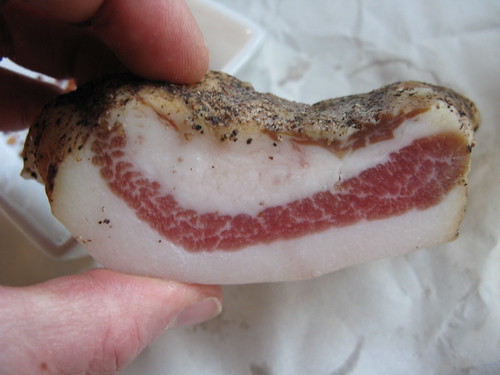
The tomatoes are San Marzono D.O.P.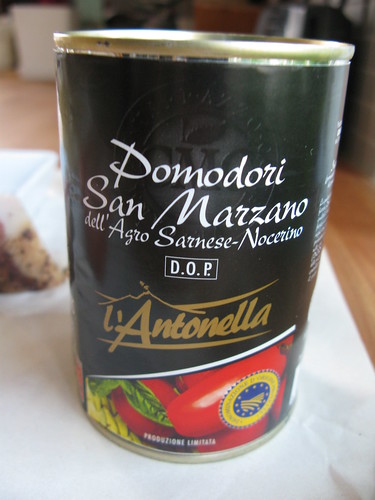
The bucatini is handmade and from an Italian pasta cooperative.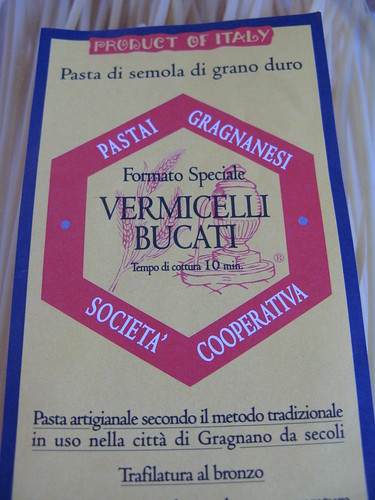
Before getting started, though, I simpy had to pay tribute to Antonious and his many-faceted areas of expertise. So, in the middle of this Italian extravaganza, I popped open a bottle of Kwak...
and indulged in a few slices of Jamon Iberico Bellota (not very Antonious but, hey, they had just gotten in a new ham at the market...):
Back to the recipe.• Fry the cubed pork in a little olive oil or lard at medium heat, rendering out the fat from the pork and ultimately making the pork pieces crispy. At this point, I like to remove some or most of the pieces of pork and set them aside.
check
check
and check• Add the chopped onion and fry but do not brown.
check• Add the pomodori pelati and chop them in the pan with a spoon or fork.
 • Add the desired amount of red chile flakes and a generous dose of freshly ground black pepper. Allow the tomato/onion mixture to cook and reduce for ca. 20 minutes; taste and adjust if necessary with the addition of salt (N.B. the pork itself adds a salty element to the dish, as will the pecorino, so beware not to add salt without tasting.)
• Add the desired amount of red chile flakes and a generous dose of freshly ground black pepper. Allow the tomato/onion mixture to cook and reduce for ca. 20 minutes; taste and adjust if necessary with the addition of salt (N.B. the pork itself adds a salty element to the dish, as will the pecorino, so beware not to add salt without tasting.)
O.K.• Meanwhile, heat water, cook bucatini just short of the desired al dente stage, drain, reserving a little of the cooking water, and add the bucatini to the sauce pan.
check• Add the crispy pork bits to the sauce pan with the bucatini, mix thoroughly, and adjust for consistency with a little of the cooking water if the sauce is too tight, cooking the pasta in the sauce for perhaps a minute or so.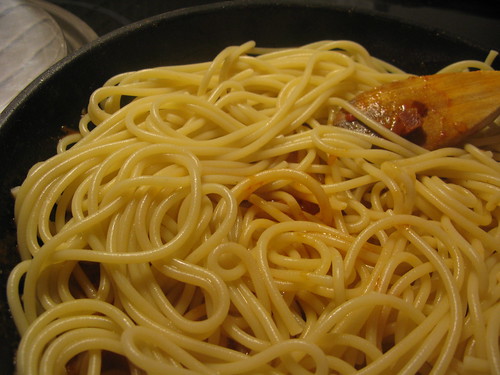
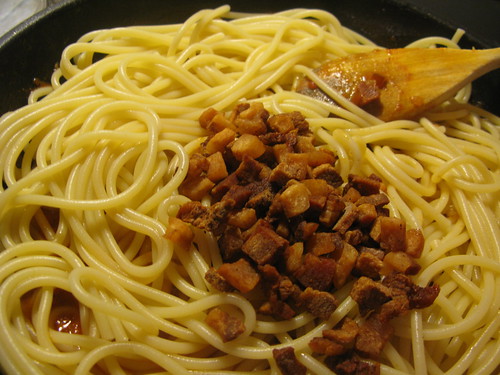
(I got a little flustered here and added the guanciale to the pasta and not the sauce... It all worked out in the end, though.)• Serve with an abundant amount of freshly grated pecorino romano and a mill for adding freshly ground black pepper.
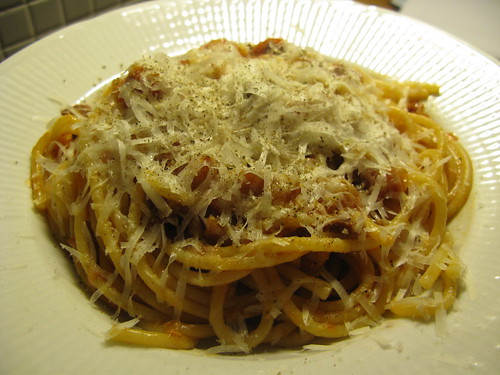
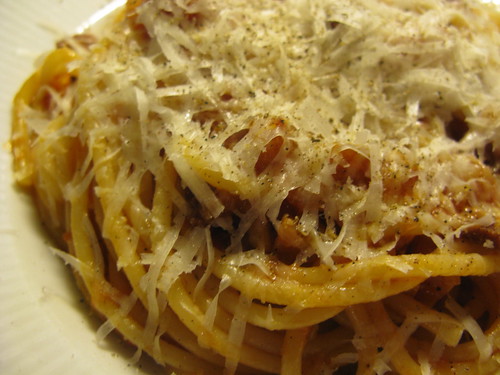
Check and check!
How was it? In one word: incredible. Weaned on years of Silver Palate cookbooks in the early 1980's, it's taken me years to break the "kitchen sink" style of cooking (a touch of this, a touch of that...). If there is one recipe that best shows off what excellent ingredients and a frugal hand with competing (even complimentary) flavorings can do, this is it. Subtle, nuanced but core-shakingly satisfying. Thank you, Antonious. Thank you!

